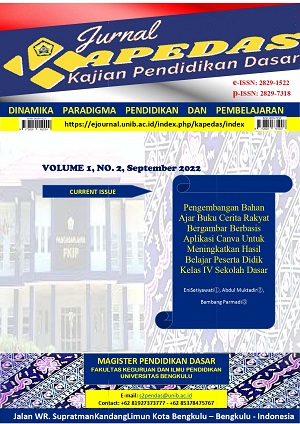Main Article Content
Abstract
This study aims to describe the development, feasibility, and response of students to STEM-Based LKPD with Theme 8 Bumiku for Class VI in Science Subjects. The type of research is research and development by modifying the Sugiyono model adopting 6 steps, namely potential problems, planning information gathering, product design, design validation, product revision, product testing. Research data obtained through questionnaires, interview guidelines, validation sheets, and student responses. Aspects that are validated include the feasibility of the material, language, presentation and graphics. The results of the research and development show that: 1) STEM-based LKPD was developed through six stages of development, namely the potential problem stage, information gathering, planning, product design, design validation, product revision, limited trial; STEM-based worksheets meet the feasibility in the aspects of material, language, presentation, and graphics that are suitable for use in learning because on average each feasibility obtains valid results and the reliability is very strong; 3) The response of the STEM-based LKPD is very good because the relationship between science and mathematics content has been integrated quite well. Based on the results of research and development, it is concluded that STEM-based worksheets are very suitable for use in learning science content for grade VI elementary school students.
Keywords
Article Details
Copyright (c) 2022 Neti Suryani

This work is licensed under a Creative Commons Attribution-ShareAlike 4.0 International License.

Karya ini dilisensikan di bawah Creative Commons Attribution-ShareAlike 4.0 International License .
References
- Cooper, J, M., Irizarry, J. G., & Leighton, M. S. (2011). Classroom teaching
- skills 9?? ed.). USA: Wadsworth, Cengage Learning.
- Hartini, S., Mariani, I., Misbah, & Sulaeman, N.F. 2020. Developing of students worksheets through STEM approach to train critical thinking skills. Journal of Physics:Conference Series, 1567(4):1-9.Kumala, F. N., (2016).
- Kurniawan, H. (2020). Pembelajaran Era 4.0: Integrasi Penguatan Pendidikan Karakter, Keterampilan Abad 21, HOTS, dan Literasi dalam Perspektif Merdeka Belajar. Yogyakarta: Media Akademi.
- Prastowo, A. (2017). Pengembangan BahanAjar Tematik Panduan Lengkap Aplikatif. Yogyakarta: DivaPress.
- Simatupang, H., Sianturi, A., & Alwardah, N. (2019). Pengembangan LKPD Pendekatan Science, Technology, Engineering, and Mathematics (STEM) untuk Menumbuhkan Keterampilan Berpikir Kritis Siswa. Jurnal Pelita Pendidikan: Journal of Biology Education, 7 (4), 170-177.
- Sugiyono. (2019). Metode Penelitian Pendidikan (Kuantitatif, Kualitatif, Kombinasi, R & D, dan Penelitian Pendidikan). Bandung: Alfabeta.
- Sukmagati, O. P., Yulianti, D., Sugianto. (2020). Pengembangan Lembar Kerja Siswa (LKS) Berbasis STEM (Science, Technology, Engineering, and Mathematics) untuk Meningkatkan Kemampuan Berpikir Kreatif Siswa SMP. Unnes Physics Education Journal, 9 (1): 18-26.
- Trianto. (2016). Model Pembelajaran Terpadu. Jakarta: PT Bumi Aksara.
- Winarni, E. W. (2018). Teori dan Praktik Penelitian Kuantitatif Kualitatif Penelitian Tindakan Kelas (PTK) Reseach And Development (R&D). Jakarta: Bumi Aksara.
- Mawaddah, R., Triwoelandari, R., Irfani, F., (2022). Kelayakan LKS Pembelajaran IPA berbasis STEM untuk Meningkatkan Keterampilan Kolaborasi Siswa SD/MI. Jurnal Cakrawala Pendas. Vo. 8, No. 1, Januari 2022. E-ISSN: 2579-4442
References
Cooper, J, M., Irizarry, J. G., & Leighton, M. S. (2011). Classroom teaching
skills 9?? ed.). USA: Wadsworth, Cengage Learning.
Hartini, S., Mariani, I., Misbah, & Sulaeman, N.F. 2020. Developing of students worksheets through STEM approach to train critical thinking skills. Journal of Physics:Conference Series, 1567(4):1-9.Kumala, F. N., (2016).
Kurniawan, H. (2020). Pembelajaran Era 4.0: Integrasi Penguatan Pendidikan Karakter, Keterampilan Abad 21, HOTS, dan Literasi dalam Perspektif Merdeka Belajar. Yogyakarta: Media Akademi.
Prastowo, A. (2017). Pengembangan BahanAjar Tematik Panduan Lengkap Aplikatif. Yogyakarta: DivaPress.
Simatupang, H., Sianturi, A., & Alwardah, N. (2019). Pengembangan LKPD Pendekatan Science, Technology, Engineering, and Mathematics (STEM) untuk Menumbuhkan Keterampilan Berpikir Kritis Siswa. Jurnal Pelita Pendidikan: Journal of Biology Education, 7 (4), 170-177.
Sugiyono. (2019). Metode Penelitian Pendidikan (Kuantitatif, Kualitatif, Kombinasi, R & D, dan Penelitian Pendidikan). Bandung: Alfabeta.
Sukmagati, O. P., Yulianti, D., Sugianto. (2020). Pengembangan Lembar Kerja Siswa (LKS) Berbasis STEM (Science, Technology, Engineering, and Mathematics) untuk Meningkatkan Kemampuan Berpikir Kreatif Siswa SMP. Unnes Physics Education Journal, 9 (1): 18-26.
Trianto. (2016). Model Pembelajaran Terpadu. Jakarta: PT Bumi Aksara.
Winarni, E. W. (2018). Teori dan Praktik Penelitian Kuantitatif Kualitatif Penelitian Tindakan Kelas (PTK) Reseach And Development (R&D). Jakarta: Bumi Aksara.
Mawaddah, R., Triwoelandari, R., Irfani, F., (2022). Kelayakan LKS Pembelajaran IPA berbasis STEM untuk Meningkatkan Keterampilan Kolaborasi Siswa SD/MI. Jurnal Cakrawala Pendas. Vo. 8, No. 1, Januari 2022. E-ISSN: 2579-4442
